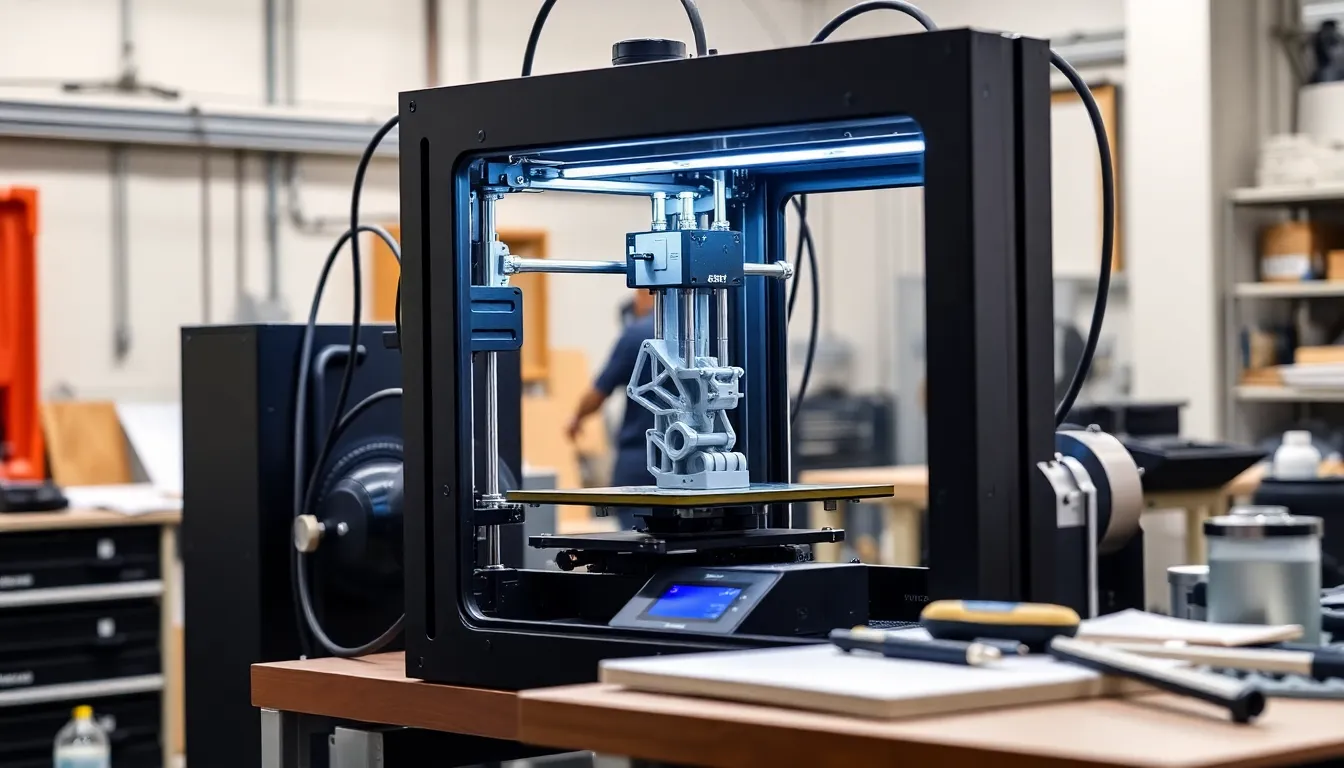Imagine a world where your wildest design dreams can be brought to life with just a few clicks. Welcome to the 3D manufacturing industry, where creativity meets technology in a mind-blowing fusion. This isn’t just about making cool toys or fancy prototypes; it’s about revolutionizing how products are conceived, designed, and produced.
From aerospace to healthcare, 3D printing is transforming industries faster than you can say “layer by layer.” With its ability to create complex structures and reduce waste, it’s not just smart—it’s downright genius. So buckle up, because the future of manufacturing is here, and it’s 3D-printed, baby! Get ready to dive into the fascinating world of 3D manufacturing, where the only limit is your imagination (and maybe your printer’s filament).
Table of Contents
ToggleOverview of the 3D Manufacturing Industry
3D manufacturing, driven by advancements in technology, reshapes traditional production methods. Industries such as aerospace, automotive, healthcare, and consumer goods significantly benefit from this shift. The process enables the creation of complex designs that are often impossible to achieve with conventional manufacturing.
Specific benefits of 3D printing include reduced material waste and lower energy consumption. Instead of traditional subtractive manufacturing, additive processes build products layer by layer, optimizing material utilization. This aspect aligns with sustainability goals, making 3D manufacturing an appealing choice for eco-conscious companies.
The market size for 3D printing reached approximately $15.2 billion in 2020 and is projected to grow at a compound annual growth rate (CAGR) of 21% from 2021 to 2028, according to industry reports. Rapid prototyping and customized production have become key drivers of this growth. Businesses leverage these capabilities to enhance product development cycles and respond quickly to consumer demands.
A variety of materials, including plastics, metals, and ceramics, are used in 3D printing, catering to diverse applications. Each material offers unique properties, impacting strength, flexibility, and durability. In aerospace, lightweight components reduce fuel consumption, while healthcare applications focus on personalized medical devices and implants.
Innovations continue to emerge within the industry. Technologies like multi-material and bioprinting open new avenues for development. Enhanced software tools improve design processes, allowing for greater precision and creativity. As 3D manufacturing evolves, its influence on global supply chains, production efficiency, and product customization becomes increasingly pronounced.
Key Technologies in the 3D Manufacturing Industry

3D manufacturing encompasses various technologies that revolutionize production methods. Key techniques include additive and subtractive manufacturing, each serving distinct purposes across industries.
Additive Manufacturing
Additive manufacturing refers to the process of building objects layer by layer. It utilizes materials like plastics, metals, and ceramics to create complex geometries and designs. This technology allows for rapid prototyping, reducing development cycles significantly. Customization is another advantage, with businesses able to produce tailored solutions for specific customer needs. Enhanced efficiency results from reduced material waste, as only the necessary amount is used for production. The versatility of additive manufacturing makes it appealing across sectors like aerospace and healthcare, where innovative solutions are in demand.
Subtractive Manufacturing
Subtractive manufacturing involves removing material from a solid block to achieve the desired shape. Techniques such as milling, drilling, and turning are common in this process. Materials like metals and plastics are often used, enabling the production of precise components. This approach ensures high accuracy and fine surface finishes, essential for critical applications. While subtractive methods have long been established, they offer less flexibility than additive manufacturing. However, they remain crucial in situations requiring durability and strength, particularly in the automotive and heavy machinery industries.
Applications of 3D Manufacturing
3D manufacturing plays a pivotal role across various industries, enhancing product design and production capabilities. Its applications span aerospace, healthcare, and numerous other sectors.
Aerospace and Defense
Aerospace and defense heavily rely on 3D manufacturing techniques to create lightweight components. Custom parts produced through additive manufacturing facilitate improved fuel efficiency. Parts with intricate geometries emerge that traditional manufacturing struggles to achieve. Rapid prototyping accelerates design revisions, allowing for swift responses to technological advancements. Furthermore, reduced waste in production lowers costs, aligning with sustainability initiatives across the industry. Companies harness diverse materials like titanium and polymers to meet stringent aviation standards.
Healthcare and Medical Devices
Healthcare benefits immensely from 3D manufacturing, particularly in medical devices and prosthetics. Customized implants and surgical tools designed for individual patients increase success rates and enhance recovery. Bioprinting advancements enable the creation of tissues and organs, representing a groundbreaking future in transplants. This technology minimizes surgery times while improving outcomes. Medical professionals utilize 3D printing for anatomical models, aiding in pre-surgical planning by providing realistic representations. As a result, patient-specific solutions transform treatment approaches, improving overall experiences in healthcare delivery.
Challenges Facing the 3D Manufacturing Industry
3D manufacturing faces several challenges that could impede its growth and development across various sectors. Key issues include material limitations and regulatory hurdles that must be addressed to fully realize the technology’s potential.
Material Limitations
Material constraints pose significant challenges in 3D manufacturing. Most commonly used materials like plastics and metals offer specific properties, yet many applications require advanced materials that aren’t readily available. Emerging materials such as composites and biomaterials, although promising, need more research for enhanced performance. Testing and certification processes also remain time-consuming, which can delay market entry for new materials. Innovations in material science can drive progress, but the industry lacks adequate resources for extensive development. Finding the right balance between functionality, cost, and availability plays a critical role in advancing applications in industries such as aerospace and healthcare.
Regulatory Hurdles
Regulatory challenges impede the growth of the 3D manufacturing industry. Compliance standards remain inconsistent across various sectors, particularly in healthcare and aerospace. 3D-printed components often lack established benchmarks for safety and efficacy, complicating the approval process. Although some agencies have made strides in developing guidelines, these efforts require time and collaboration. Additional training on regulations is needed for manufacturers to navigate the complex landscape. Ensuring that standards keep pace with technological advancements is essential for fostering buyer confidence and encouraging wider adoption. By addressing these hurdles, the industry can unlock greater opportunities for innovation and expansion.
The Future of the 3D Manufacturing Industry
The future of the 3D manufacturing industry promises to be transformative, driven by continuous innovation and market dynamics.
Innovations on the Horizon
Emerging technologies are poised to revolutionize the 3D manufacturing landscape. Advances in multi-material printing enable complex designs that combine various materials, enhancing functionality. Furthermore, developments in bioprinting open new avenues in healthcare, potentially allowing for the creation of functional tissues and organs. Software technologies continue to evolve, streamlining design processes and improving user accessibility. Researchers are also exploring the potential of metal 3D printing, targeting applications in aerospace and automotive. Each of these innovations will likely contribute significantly to the industry’s growth trajectory.
Market Trends
Projected growth for the 3D printing market stands at 21% from 2021 to 2028, indicating robust demand across sectors. Industries have begun to prioritize rapid prototyping and customization, fostering faster product development cycles. Sustainability remains a key focus, with businesses aiming to reduce material waste and energy consumption through tailored manufacturing solutions. Consumers show increasing interest in personalized products, pushing manufacturers to adapt their offerings. Additionally, advancements in artificial intelligence are enhancing production efficiency, reinforcing the importance of technology in shaping future trends. These shifts paint a promising picture for the 3D manufacturing industry ahead.
The 3D manufacturing industry stands at the forefront of innovation and transformation. As it continues to evolve, businesses across various sectors are discovering the immense potential of this technology. With its ability to create complex designs while promoting sustainability, 3D printing is redefining production methods and enhancing efficiency.
Emerging technologies promise to further revolutionize the landscape, making customization and rapid prototyping more accessible than ever. As manufacturers embrace these advancements, the industry is poised for significant growth. The future of 3D manufacturing is bright, and its impact on global supply chains and product development will only deepen. Embracing this technology is no longer optional; it’s essential for staying competitive in today’s fast-paced market.





